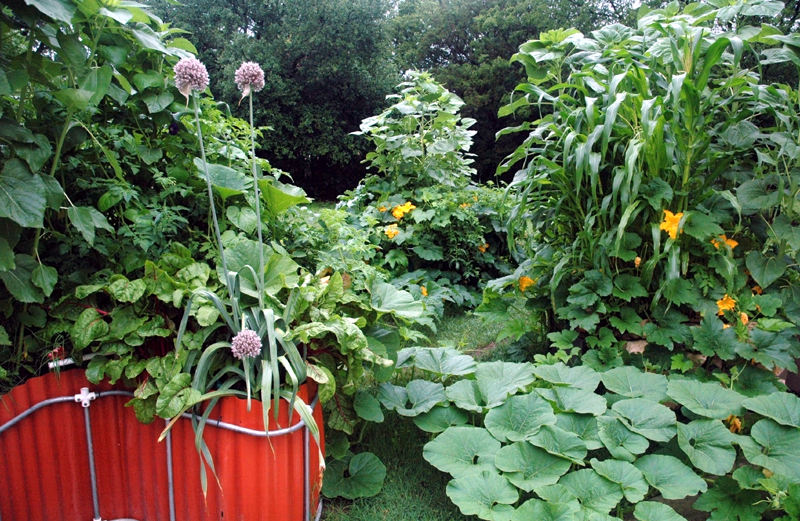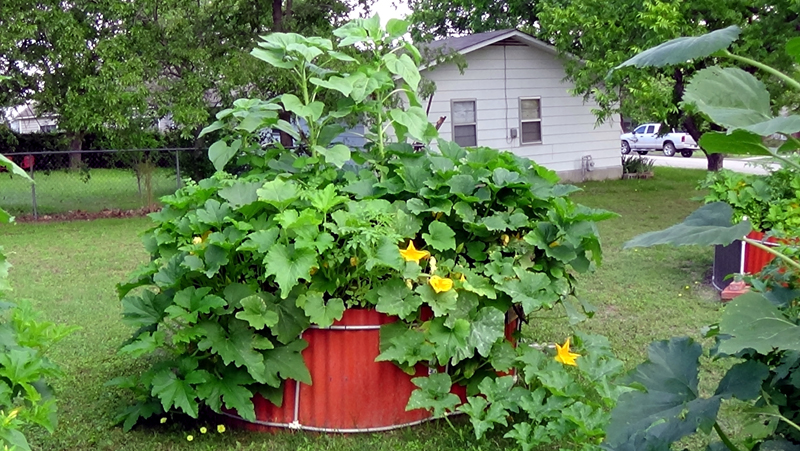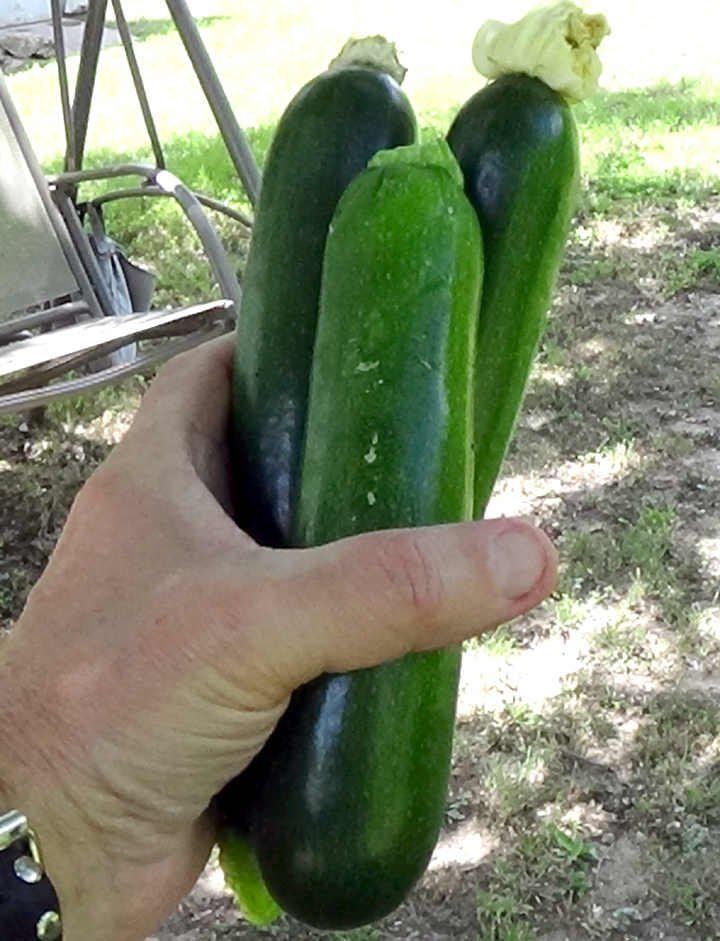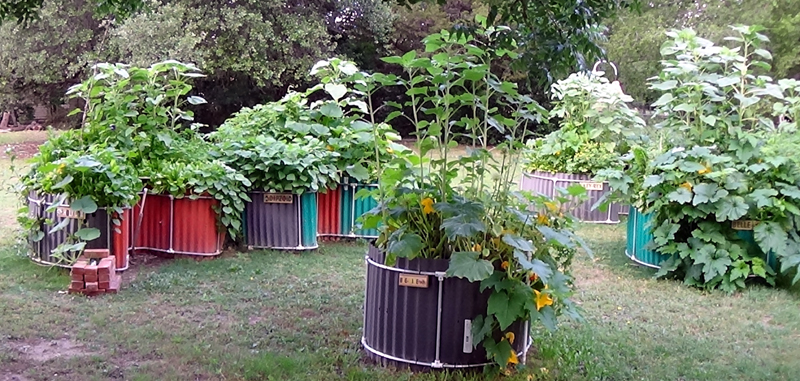 It’s been about 10 days since the last update, but since every day shows significant growth of Keyhole Farm’s keyhole gardens, here we go again. I am stuck in a dilemma, since I now want some plants to quit making so that I can make room to plant my okra and black-eyed peas for summer, but everything is so healthy that it is a difficult decision as to what to pull up. I keep putting it off.
It’s been about 10 days since the last update, but since every day shows significant growth of Keyhole Farm’s keyhole gardens, here we go again. I am stuck in a dilemma, since I now want some plants to quit making so that I can make room to plant my okra and black-eyed peas for summer, but everything is so healthy that it is a difficult decision as to what to pull up. I keep putting it off.
We have added a new dimension to this website — some videos that perhaps provide a realistic close-up view of how gardening in a keyhole is a wonderful experience.
 A few still photos of the our gardens as they looked on May 24 are on this page. Simply click on the photo to enlarge, then click off it to reduce.
A few still photos of the our gardens as they looked on May 24 are on this page. Simply click on the photo to enlarge, then click off it to reduce.
 So far, we have been picking sweet peas, green beans, squash, lettuce, Swiss chard, and spinach, to name a few. About 85 percent of these gardens were planted from seeds, the rest via small plants.
So far, we have been picking sweet peas, green beans, squash, lettuce, Swiss chard, and spinach, to name a few. About 85 percent of these gardens were planted from seeds, the rest via small plants.
I could spend all day watching these gardens and tending them some, just for the pleasure of it. In one of the keyholes, named Key Rex (a gray one), I had installed a home-made bird feeder in the guise of a gourd that I picked last year. Birds really like it. Interestingly, I installed it high above the garden, but now it is being surpassed by plants growing up to meet it. The same thing happened with a tree stump that we had cut earlier in the year. A slice of it looked like a four-leaf clover, so we installed it above the inner basket in a garden named “Lucky.” It, too, has now been surpassed in height by plants.
 One of the great things about keyhole gardening is that you can do it all year; it’s never too late to start. I realize that most people consider spring the best time to begin, partially because there is an itch to get outdoors after winter. However, keyhole gardens offer planting opportunities all year round. It’s a matter, basically, of matching the crops to the season in which they flourish. To me, summer is the best time to raise okra and black-eyed peas and I want to get a jump on it if possible, but I still have too many spring crops that are extremely healthy. I imagine I will do what I always do, pull up just a few here and there and put some seeds in the ground where they were, doing this on several occasions as we advance into summer.
One of the great things about keyhole gardening is that you can do it all year; it’s never too late to start. I realize that most people consider spring the best time to begin, partially because there is an itch to get outdoors after winter. However, keyhole gardens offer planting opportunities all year round. It’s a matter, basically, of matching the crops to the season in which they flourish. To me, summer is the best time to raise okra and black-eyed peas and I want to get a jump on it if possible, but I still have too many spring crops that are extremely healthy. I imagine I will do what I always do, pull up just a few here and there and put some seeds in the ground where they were, doing this on several occasions as we advance into summer.
 The “key” advantages of keyholes is that they conserve water, you can plant crops very close together, because of the raised bed it is easy on the back, there is little or no weeding, recycling provides an excellent way to naturally nourish the crops through the internal basket, plus the fill material in the garden is primarily recycled material (like paper goods, cardboard boxes, twigs, leaves, etc.). With our kits, you can get right up to the plants to work them (ADA compliant), they are durable (our oldest kit-related keyhole is in its sixth year and still going strong), plus they are lightweight and semi-portable (can be partially disassembled and moved).
The “key” advantages of keyholes is that they conserve water, you can plant crops very close together, because of the raised bed it is easy on the back, there is little or no weeding, recycling provides an excellent way to naturally nourish the crops through the internal basket, plus the fill material in the garden is primarily recycled material (like paper goods, cardboard boxes, twigs, leaves, etc.). With our kits, you can get right up to the plants to work them (ADA compliant), they are durable (our oldest kit-related keyhole is in its sixth year and still going strong), plus they are lightweight and semi-portable (can be partially disassembled and moved).
 Even with the prolonged Texas drought, we have had great success year after year raising huge, tasty crops in our keyholes with minimal watering. It’s a great way to feed the family or at least supplement the food supply in a natural, healthy manner. I don’t know why, but when you grow your own crops they tend to taste better. You pick them yourself, fresh from the vine, and have total control over these elements.
Even with the prolonged Texas drought, we have had great success year after year raising huge, tasty crops in our keyholes with minimal watering. It’s a great way to feed the family or at least supplement the food supply in a natural, healthy manner. I don’t know why, but when you grow your own crops they tend to taste better. You pick them yourself, fresh from the vine, and have total control over these elements.